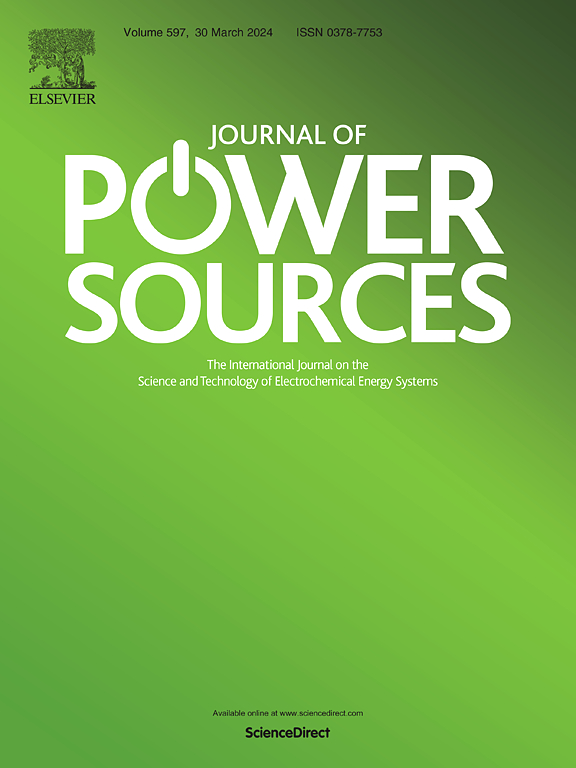Breaking the conductivity-selectivity trade-off in direct methanol fuel cells using oxygen plasma-treated monolayer graphene
IF 7.9
2区 工程技术
Q1 CHEMISTRY, PHYSICAL
引用次数: 0
Abstract
Direct methanol fuel cells (DMFCs) offer a simpler fuel system than hydrogen fuel cells and hold promise for portable and small-scale power generation. However, the methanol crossover issue of commercial Nafion membranes causes mixed potential in the cathode, lowering open circuit voltage (OCV) and overall performance. While incorporating monolayer graphene into Nafion membranes can mitigate methanol crossover and improve OCV, it often compromises proton conductivity. In this study, we demonstrate that oxygen plasma-treated monolayer graphene embedded in a Nafion membrane enhances both proton conductivity and selectivity. This dual improvement results in a 92.74 % increase in DMFC performance compared to commercial Nafion membranes, with power outputs of 134.56 mW cm−2 at 60 °C and 254.84 mW cm−2 at 90 °C. Molecular dynamics simulations indicate that oxygen-containing functional groups introduced through plasma treatment form nanopores that enhance interfacial affinity between graphene and Nafion, leading to better water distribution at the interface and improved proton conduction. This approach effectively breaks the conductivity-selectivity trade-off, offering a viable solution to improve DMFC performance.
利用氧等离子体处理单层石墨烯,打破了直接甲醇燃料电池的电导率-选择性权衡
直接甲醇燃料电池(dmfc)提供了一种比氢燃料电池更简单的燃料系统,并有望用于便携式和小规模发电。然而,商用Nafion膜的甲醇交叉问题导致阴极混合电位,降低了开路电压(OCV)和整体性能。虽然将单层石墨烯加入Nafion膜可以减轻甲醇交叉并改善OCV,但它通常会损害质子的导电性。在这项研究中,我们证明了氧等离子体处理的单层石墨烯嵌入在Nafion膜中,可以提高质子的导电性和选择性。与商用Nafion膜相比,这种双重改进使DMFC性能提高了92.74%,在60°C和90°C下的功率输出分别为134.56 mW cm - 2和254.84 mW cm - 2。分子动力学模拟表明,通过等离子体处理引入的含氧官能团形成纳米孔,增强了石墨烯和Nafion之间的界面亲和力,从而改善了界面上的水分布,改善了质子传导。这种方法有效地打破了电导率与选择性之间的权衡,为提高DMFC性能提供了可行的解决方案。
本文章由计算机程序翻译,如有差异,请以英文原文为准。
求助全文
约1分钟内获得全文
求助全文
来源期刊

Journal of Power Sources
工程技术-电化学
CiteScore
16.40
自引率
6.50%
发文量
1249
审稿时长
36 days
期刊介绍:
The Journal of Power Sources is a publication catering to researchers and technologists interested in various aspects of the science, technology, and applications of electrochemical power sources. It covers original research and reviews on primary and secondary batteries, fuel cells, supercapacitors, and photo-electrochemical cells.
Topics considered include the research, development and applications of nanomaterials and novel componentry for these devices. Examples of applications of these electrochemical power sources include:
• Portable electronics
• Electric and Hybrid Electric Vehicles
• Uninterruptible Power Supply (UPS) systems
• Storage of renewable energy
• Satellites and deep space probes
• Boats and ships, drones and aircrafts
• Wearable energy storage systems
 求助内容:
求助内容: 应助结果提醒方式:
应助结果提醒方式:


